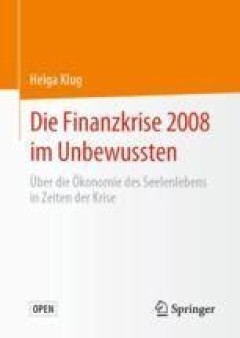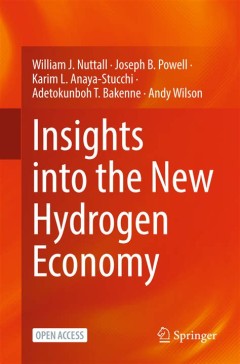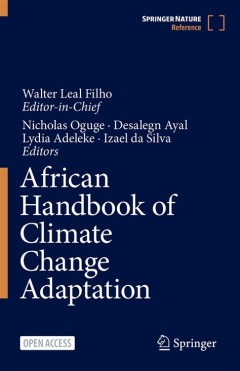Filter by

Global Citizenship Education = Critical and International Perspectives
This open access book takes a critical and international perspective to the mainstreaming of the Global Citizenship Concept and analyses the key issues regarding global citizenship education across the world. In that respect, it addresses a pressing need to provide further conceptual input and to open global citizenship agendas to diversity and indigeneity. Social and political changes brought…
- Edition
- 1
- ISBN/ISSN
- 9783030446178
- Collation
- XIV, 217 hlm; ill., lamp.,
- Series Title
- -
- Call Number
- -

Die Finanzkrise 2008 im Unbewussten = Über die Ökonomie des Seelenlebens in…
Helga Klug eröffnet in diesem Open-Access-Buch neue ungewohnte Sichtweisen auf die psychische Verarbeitung der Finanzkrise 2008. Dabei rückt die Autorin unbewusste Prozesse in den Fokus, wie sie in Krisenmodellen, Abwehrmechanismen, Zukunftserwartungen, sozialen Beziehungen und Affekten, die das Krisenerleben begleiten, zum Ausdruck kommen. Die Krise, die bisher nicht hinreichend erfasst und …
- Edition
- 1
- ISBN/ISSN
- 9783658284756
- Collation
- -
- Series Title
- -
- Call Number
- -

Umwelt- und Bioressourcenmanagement für eine nachhaltige Zukunftsgestaltung
In diesem Open Access-Buch werden fünf zentrale Themenbereiche des Umwelt- und Bioressourcenmanagement (UBRM) vorgestellt. Umwelt- und Bioressourcenmanagerinnen und -manager kennen die Herausforderungen des 21. Jahrhunderts, wie sie zum Beispiel in der Agenda 2030 der Vereinten Nationen – den sogenannten nachhaltigen Entwicklungszielen (Sustainable Development Goals - SDGs) – formu…
- Edition
- 1
- ISBN/ISSN
- 9783662604359
- Collation
- XIV, 273 hlm; ill., lamp.,
- Series Title
- -
- Call Number
- -

Rescaling Sustainability Transitions = Unfolding the Spatialities of Power Re…
This Open Access book explores sustainability transitions with a focus on their influence on the relationships between cores and peripheries, the rural and the urban, and the large and the small-scale. The societal changes induced by sustainability transitions are expected to assemble as a variegated and heterogeneous process reproduced by different spatial contexts and scales. Hence, the pract…
- Edition
- 1
- ISBN/ISSN
- 9783031699184
- Collation
- XVII, 299 hlm; ill., lamp.,
- Series Title
- -
- Call Number
- -

Political Leadership and Agricultural Transformation = A New Research Agenda
This open access book examines the impact of political leadership on agricultural transformation to understand why cases of successful agricultural transformation are so rare in the developing world. It highlights the importance of leadership and its interaction with the socio-political system as a key factor impacting agricultural transformation. The book takes a first step in systematically e…
- Edition
- 1
- ISBN/ISSN
- 9783031698521
- Collation
- XV, 84 hlm; ill., lamp.,
- Series Title
- -
- Call Number
- -

Strengthening European Climate Policy = Governance Recommendations from Innov…
This open-access book foregrounds 10 novel collaborations between the Social Sciences and Humanities (SSH), and Science, Technology, Engineering and Mathematics (STEM) disciplines, for strengthening European climate policy. Part of a three-volume collection covering climate, energy, and mobility policy.
- Edition
- 1
- ISBN/ISSN
- 9783031720550
- Collation
- XXXV, 163 hlm; ill., lamp.,
- Series Title
- -
- Call Number
- -

Insights into the New Hydrogen Economy
This open access book offers a comprehensive exploration of the future of the hydrogen industry. It builds upon insights gathered from a series of expert workshops and follow-on activity. International experts from various fields, including industry, public policy, and academia, engaged in dialogue and knowledge exchange, resulting in invaluable findings and observations. This book builds upon…
- Edition
- 1
- ISBN/ISSN
- 9783031718335
- Collation
- XXIX, 162 hlm; ill., lamp.,
- Series Title
- -
- Call Number
- -

Economic Evaluation of Sustainable Development
This book is open access under a CC BY 4.0 license. This book presents methods to evaluate sustainable development using economic tools. The focus on sustainable development takes the reader beyond economic growth to encompass inclusion, environmental stewardship and good governance. Sustainable Development Goals (SDGs) provide a framework for outcomes. In illustrating the SDGs, the book emp…
- Edition
- 1
- ISBN/ISSN
- 9789811363894
- Collation
- XXIII, 145 ill; lamp
- Series Title
- -
- Call Number
- -

African Handbook of Climate Change Adaptation
This open access book discusses current thinking and presents the main issues and challenges associated with climate change in Africa. It introduces evidences from studies and projects which show how climate change adaptation is being - and may continue to be successfully implemented in African countries. Thanks to its scope and wide range of themes surrounding climate change, the ambition is t…
- Edition
- 1
- ISBN/ISSN
- 9783030451066
- Collation
- LIX, 2838 hlm; ill., lamp.,
- Series Title
- -
- Call Number
- -

African Handbook of Climate Change Adaptation
This open access book discusses current thinking and presents the main issues and challenges associated with climate change in Africa. It introduces evidences from studies and projects which show how climate change adaptation is being - and may continue to be successfully implemented in African countries. Thanks to its scope and wide range of themes surrounding climate change, the ambition is t…
- Edition
- 1
- ISBN/ISSN
- 9783030420918
- Collation
- 2656 hlm; ill., lamp.,
- Series Title
- -
- Call Number
- -
 Computer Science, Information & General Works
Computer Science, Information & General Works  Philosophy & Psychology
Philosophy & Psychology  Religion
Religion  Social Sciences
Social Sciences  Language
Language  Pure Science
Pure Science  Applied Sciences
Applied Sciences  Art & Recreation
Art & Recreation  Literature
Literature  History & Geography
History & Geography